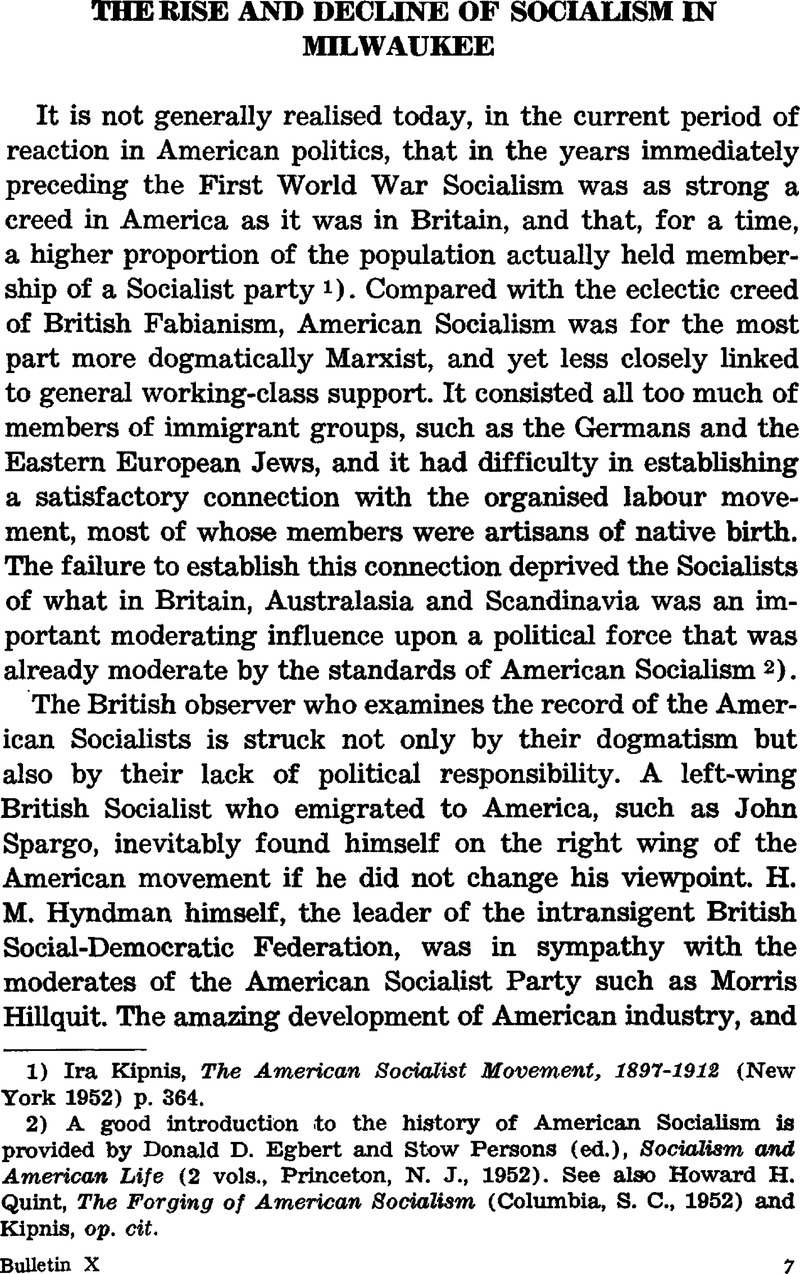Published online by Cambridge University Press: 18 December 2008

1) Ira, Kipnis, The American Socialist Movement, 1897–1912 (New York 1952) p. 364.Google Scholar
2) A good introduction to the history of American socialism is provided by Donald, D. Egbert and Stow, Persons (ed.), Socialism and American Life (2 vols., Princeton, N. J., 1952).Google Scholar See also Howard, H. Quint, The Forging of American socialism (Columbia, S. C., 1952)Google Scholar and Kipnis, , op. cit.Google Scholar
3) Bayrd, Still, Milwaukee, the History of a City (Madison, Wis., 1948) pp. 122–4.Google Scholar
4) Mervin, Wachman, History of the Social-Democratic Party of Milwaukee, 1897–1910 (Urbana, Ill., 1945) pp. 10f.Google Scholar
5) Wachman, , op. cit., pp. 11–13. There could be no conscious imitation of the British Labour Party, however, for it was not founded until 1900.Google Scholar
6) Ray, Ginger, The Bending Cross (New Brunswick, N. J., 1949) p. 173Google Scholar
7) Kipnis, , op. cit., chs. iv-vi.Google Scholar
8) These and subsequent details of Socialist successes on the Common Council are taken from a typescript in the Milwaukee Municipal Reference Library, entitled ‘Socialist Representation in the Common Council of Milwaukee’.
9) Thaddeus, Borun (ed.), We, the Milwaukee Poles (Milwaukee, 1946).Google Scholar
10) Berger to Hillquit, 8 Apr 1905 (Hillquit Papers, Wisconsin State Historical Society). Berger maintained at this time that the Socialists' chief support came not from immigrants, but from their children, who had been educated in the American public schools — Independent, 21 April 1910.
11) Seidel's private secretary during his term of office was Carl Sandburg. Karl, Detzer, Carl Sandburg (New York, 1941) p. 83.Google Scholar
12) Oscar Ameringer, in his autobiography If You Don't Weaken (New York, 1940), gives an account of campaigning for Berger among the rural German farmers of Waukesha county.Google Scholar
13) Frederick, I. Olsen, ‘The Milwaukee Socialists’ (unpub. Ph. D. thesis, Harvard, 1952) p. 58.Google Scholar
14) John, R. Commons, Myself (New York, 1934) p. 152.Google Scholar
15) Still, , op. cit., pp. 516–520.Google Scholar
16) Rosalind, M. Drosen, ‘History of Socialism in Milwaukee, 1910–30’ (unpub. B. A. thesis, Wisconsin U., 1931) pp. 26ff.Google Scholar
17) This episode is recounted in Henry, F. Bedford, ‘A Case Study in Hysteria — Victor L. Berger, 1917–21’ (unpub. M. A. thesis, Wisconsin U., 1953).Google Scholar
18) David, Shannon, ‘Decline of the American Socialist Party’ (unpub. Ph. D. thesis, Wisconsin U., 1950) p. 150.Google Scholar
19) Louis, Waidman, Labor Lawyer (New York, 1944) p. 260.Google Scholar
20) Victor, Berger, Speech in Congress, 16 Feb 1924, quoted Voice and Pen of Victor Berger, Milwaukee, 1929, p. 23.Google Scholar
21) Irving, S. Tarrant, ‘A Study of Election Propaganda in Milwaukee Mayoralty Campaths, 1916–1928’ (unpub. B. A. thesis, 1928) p. 94.Google Scholar
22) Drosen, , op. cit., pp. 53f.Google Scholar For his own account of his mayoralty, see Daniel, W. Hoan, City Government (New York, 1936).Google Scholar
23) Milwaukee Writers' Project, ‘History of Milwaukee County’ (unpub. 1947: typescript in Milwaukee Public Library) p. 167. For a contemporary account of the coalition, see Milwaukee Sentinel, 30 04 1932.Google Scholar The problem of finding appointments for Poles caused some ill-feeling among the Socialists: see Milwaukee Journal, 25 03 1948 (a historical article).Google Scholar
24) Still, , op. cit., p. 527.Google Scholar
25) Milwaukee Journa, 4 04 1940, which attributes much of Carl Zeidler's popularity to his performance as a baritone — a valuable asset in a city with strong musical traditions.Google Scholar
26) Harry, W. Laidler, Towartis a Farmer-Labor Party (New York, 1938) pp. 25–30;Google ScholarRaney, W. F., Wisconsin, A Story of Progress (New York, 1940) pp. 366f. In 1944 Hoan stood as Democratic candidate for Governor of Wisconsin.Google Scholar
27) In 1952 Zeidler's non-partisan opponent, a Pole, won only one of the wards — a predominantly Polish one. Milwaukee Journal, 2 04 1952.Google Scholar
28) The Milwaukee Journal, by no means a Socialist paper, supported Zeidler for re-election in 1952. See editorial of 20 Mar 1952. Zeidler secured strong backing from the A. F. of L., the C.I.O., and other labour unions. Milwaukee Journal, 21 March 1952.
29) See, e.g., his speech to the National Planning Conference at Boston, Mass., 8 Oct 1952; and his article ‘Milwaukee's Racial Tension’, Socialist Call, 03 1954, pp. 8–10.Google Scholar For recent immigration into Milwaukee, see Governor's Commission on Human Rights, Non-White Housing in Wisconsin (Madison, Wis., 1954) pp. 50–72.Google Scholar
30) See the leaflet prepared by the Public Enterprise Committee, A Civic Program for Metropolitan Milwaukee, 12 1951.Google Scholar
31) For an analysis of the factors that account for the voting habits of the various precincts, see Edwin, Bayley's article in Milwaukee Journal, 25 02 1954.Google Scholar
32) Report of Board of Election Commissioners of Milwaukee, 1953, p. 394.Google Scholar